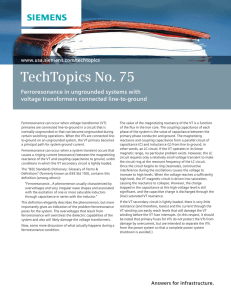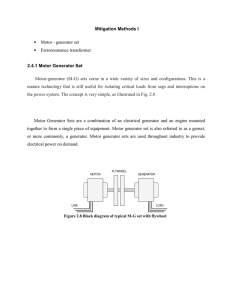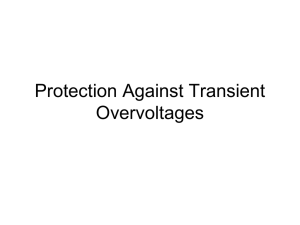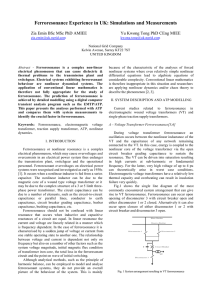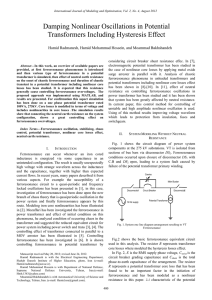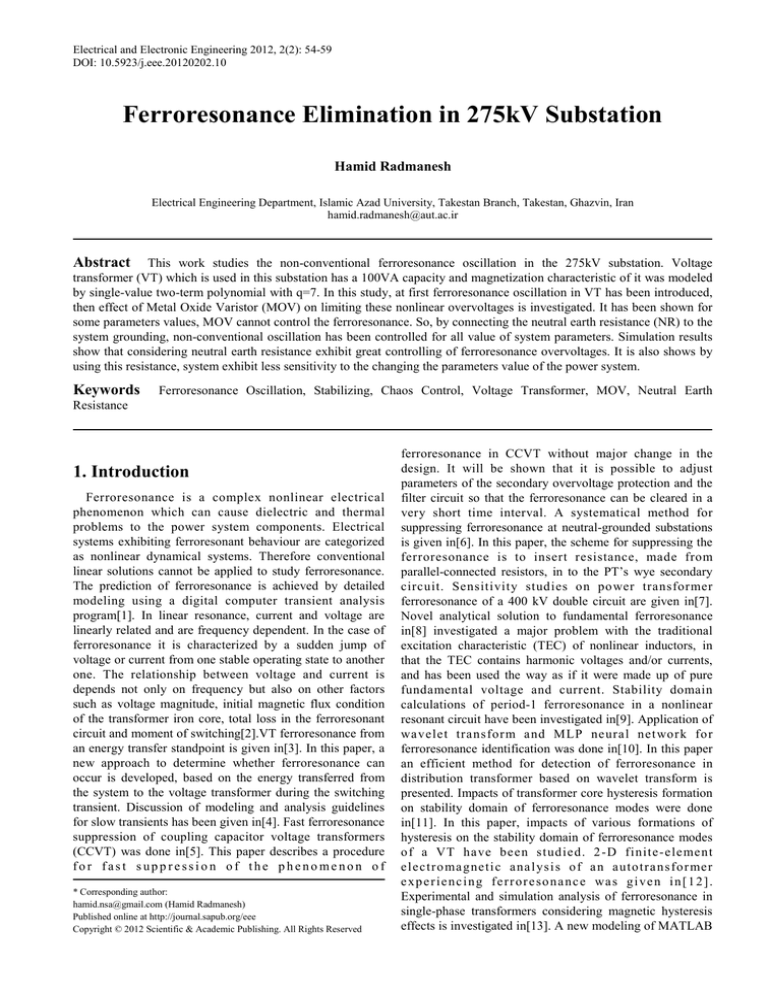
Electrical and Electronic Engineering 2012, 2(2): 54-59
DOI: 10.5923/j.eee.20120202.10
Ferroresonance Elimination in 275kV Substation
Hamid Radmanesh
Electrical Engineering Department, Islamic Azad University, Takestan Branch, Takestan, Ghazvin, Iran
hamid.radmanesh@aut.ac.ir
Abstract This work studies the non-conventional ferroresonance oscillation in the 275kV substation. Voltage
transformer (VT) which is used in this substation has a 100VA capacity and magnetization characteristic of it was modeled
by single-value two-term polynomial with q=7. In this study, at first ferroresonance oscillation in VT has been introduced,
then effect of Metal Oxide Varistor (MOV) on limiting these nonlinear overvoltages is investigated. It has been shown for
some parameters values, MOV cannot control the ferroresonance. So, by connecting the neutral earth resistance (NR) to the
system grounding, non-conventional oscillation has been controlled for all value of system parameters. Simulation results
show that considering neutral earth resistance exhibit great controlling of ferroresonance overvoltages. It is also shows by
using this resistance, system exhibit less sensitivity to the changing the parameters value of the power system.
Keywords
Resistance
Ferroresonance Oscillation, Stabilizing, Chaos Control, Voltage Transformer, MOV, Neutral Earth
1. Introduction
Ferroresonance is a complex nonlinear electrical
phenomenon which can cause dielectric and thermal
problems to the power system components. Electrical
systems exhibiting ferroresonant behaviour are categorized
as nonlinear dynamical systems. Therefore conventional
linear solutions cannot be applied to study ferroresonance.
The prediction of ferroresonance is achieved by detailed
modeling using a digital computer transient analysis
program[1]. In linear resonance, current and voltage are
linearly related and are frequency dependent. In the case of
ferroresonance it is characterized by a sudden jump of
voltage or current from one stable operating state to another
one. The relationship between voltage and current is
depends not only on frequency but also on other factors
such as voltage magnitude, initial magnetic flux condition
of the transformer iron core, total loss in the ferroresonant
circuit and moment of switching[2].VT ferroresonance from
an energy transfer standpoint is given in[3]. In this paper, a
new approach to determine whether ferroresonance can
occur is developed, based on the energy transferred from
the system to the voltage transformer during the switching
transient. Discussion of modeling and analysis guidelines
for slow transients has been given in[4]. Fast ferroresonance
suppression of coupling capacitor voltage transformers
(CCVT) was done in[5]. This paper describes a procedure
for fast suppression of the phenomenon of
* Corresponding author:
hamid.nsa@gmail.com (Hamid Radmanesh)
Published online at http://journal.sapub.org/eee
Copyright © 2012 Scientific & Academic Publishing. All Rights Reserved
ferroresonance in CCVT without major change in the
design. It will be shown that it is possible to adjust
parameters of the secondary overvoltage protection and the
filter circuit so that the ferroresonance can be cleared in a
very short time interval. A systematical method for
suppressing ferroresonance at neutral-grounded substations
is given in[6]. In this paper, the scheme for suppressing the
ferroresonance is to insert resistance, made from
parallel-connected resistors, in to the PT’s wye secondary
circuit. Sensitivity studies on po wer transformer
ferroresonance of a 400 kV double circuit are given in[7].
Novel analytical solution to fundamental ferroresonance
in[8] investigated a major problem with the traditional
excitation characteristic (TEC) of nonlinear inductors, in
that the TEC contains harmonic voltages and/or currents,
and has been used the way as if it were made up of pure
fundamental voltage and current. Stability domain
calculations of period-1 ferroresonance in a nonlinear
resonant circuit have been investigated in[9]. Application of
wavelet transfor m and MLP neural net wor k fo r
ferroresonance identification was done in[10]. In this paper
an efficient method for detection of ferroresonance in
distribution transformer based on wavelet transform is
presented. Impacts of transformer core hysteresis formation
on stability domain of ferroresonance modes were done
in[11]. In this paper, impacts of various formations of
hysteresis on the stability domain of ferroresonance modes
o f a VT have been stud ied. 2 -D finite -element
electr o ma g neti c ana l ys i s o f a n a uto tr a n s fo r mer
e x p e r ie n c i n g f e r r o r e so n a n c e wa s g i v e n i n [ 1 2 ] .
Experimental and simulation analysis of ferroresonance in
single-phase transformers considering magnetic hysteresis
effects is investigated in[13]. A new modeling of MATLAB
Electrical and Electronic Engineering 2012, 2(2): 54-59
transformer for accurate simulation of ferroresonance shows
a new modeling of transformers in Simulink/MATLAB
enabling to simulate slow transients more accurate than the
existing models used in the software[14]. Effect of
Magnetizing Curve Nonlinearity Index on the Occurring
Chaotic Ferroresonance Oscillation in Autotransformers has
been studied in[17]. In current paper, MOV and NR
connected devices are used as a control method for
stabilizing of unstable and high amplitude ferroresonance
oscillation. Using of these methods result improving voltage
waveform which leads to protection from insulation, fuses
and switchgears. This paper organized as follow: At first the
reasons of occurring ferroresonance in transformers is
described. Then various types of ferroresonance in VT are
explained. Then general introducing of controlling
ferroresonance by considering neutral earth resistance and
using it in current problem is shown.
2. Power System Modeling without
Neutral Resistance
Ferroresonance can occur where VTs are connected to
isolated sections of bus bars. Energy is coupled via the
inter-circuit capacitance of the parallel lines or open circuit
breaker grading capacitance. Specifically, the connection of
VTs to isolated section of bus bar i.e. to a low capacitance
should be avoided[15].
Grading Capacitor
bars via disconnector DS2[15]. Ferroresonance conditions
occurred upon closure of disconnector DS1 with CB and DS2
open, leading to a system fault caused by failure of the VT
primary winding. Fig. 2 shows the basic ferroresonance
equivalent circuit used in this analysis while MOV has been
connected in parallel with the VT. The resistor R represents
transformer core losses, in current paper the nonlinear
transformer magnetization curve was modeled by a single
valued seventh order polynomial obtained from the
transformer magnetization curve[14],[15].
In Fig. 2, E is the RMS supply phase voltage, Cseries is the
circuit breaker grading capacitance and Cshunt is the total
phase-to-earth capacitance of the arrangement. The resistor
R represents a voltage transformer core and MOV is a
nonlinear resistance that has been added on the transformer.
In the peak current range for steady-state operation, the
flux-current linkage can be approximated by a linear
characteristic such as i L = aλ where the coefficient of the
linear term (a) corresponds closely to the reciprocal of the
inductance ( a ≅ 1 / L) . However, for very high currents the
iron core might be driven into saturation and the flux-current
characteristic becomes highly nonlinear, here the λ − i
characteristic of the voltage transformer is modeled as in[15]
by the polynomial
i = aλ + bλ 7
(1)
where, a = 3.14 , b = 0.41
Fig. 3 shows simulation of these iron core characteristic
( λ − i ) for q=7.
1.8
Main Busbar
AC
1.4
Disconnector2
Circuit Breaker
50Hz supply
1.6
1.2
Flux (pu)
Disconnector1
55
Voltage Transformer
1
0.8
0.6
0.4
0.2
0
Figure 1. System one line diagram arrangement resulting to VT
ferroresonance[15]
Cseries
iCser
e
iL
iCshunt
Cshunt
iR
R
Ltrans
V
MOV
Figure 2.
MOV
Basic reduced equivalent ferroresonance circuit connecting
Fig. 1 shows the circuit diagram of system components at
the 275 kV substations. VT is isolated from sections of bus
0
5
10
Current (pu)
15
20
25
Figure 3. Flux- current characteristic of transformer core
The basic voltage transformer ferroresonance circuit of
Fig. 2 can be presented by a differential equation[16].
Because of the nonlinear nature of the transformer
magnetizing characteristics, the behavior of the system is
extremely sensitive to change in system parameter and initial
conditions. A small change in the value of system voltage,
capacitance or losses may lead to dramatic change in the
behavior of it. A more suitable mathematical language for
studying ferroresonance and other nonlinear systems is
provided by nonlinear dynamic methods. Mathematical tools
that are used in this analysis are phase plan diagram, time
domain simulation and bifurcation diagram.
3. Metal Oxide Varistor Model
Hamid Radmanesh et al.:
56
Ferroresonance Elimination in Voltage Transformers
MOV is highly nonlinear resistor used to protect power
equipment against overvoltages. The nonlinear V-I
characteristic of each column of the MOV is modeled by
combination of the exponential functions which is shown in
(2).
1/ α
(2)
I
V
i
Vref
= Ki
I
ref
2 E sin(ωt )
e=
where, V represents resistive voltage drop, I represents
arrester current, K is constant and α is nonlinearity constant.
Fig. 4 shows V-I characteristic of MOV that has been
simulated by the given parameters in this paper. The surge
arrester block is modeled as a current source driven by the
voltage appearing across its terminals. Therefore, it cannot
be connected in series with an inductor or another current
source. Recognition and study of chaotic ferroresonance has
fostered a whole new technology of dynamical systems in
power system. The technology collectively includes many
new and better techniques and tools in nonlinear dynamics,
time-series analysis, short and long-range prediction and
numerically characterizing non-Euclidean objects.
iL = aλ + bλ
7
dλ
vL =
dt
=
(5)
(6)
α
ωE cos ωt −
(4)
1 dλ
1 dλ
1
−
( aλ + bλ7 )
−
Rcore dt C series kdt
C series
(C series + C shunt ) d 2 λ
2
C series
dt
0
(7)
where, ω is supply frequency. The time behavior of the
basic ferroresonance circuit is described by (7). Results for
one parameters set show two possible types of
ferroresonance. Table (1) shows base values used in the
analysis and different states parameters are given in table (2).
It has been shown by applying neutral earth resistance to the
system, these two cases have been changed to the better
oscillation behavior and amplitude of overvoltages has been
greatly decreased.
-1
Table 1. Base values of the system used for simulation
3
2
Voltage of MOSA(pu)
So mathematical analyses of equivalent circuit by have
been done and equations of system can be presented here.
Arrester can be expressed by”alpha” equation:
(3)
V = KI 1 / α
The differential equation for the circuit in Fig. 2 can be
modified as follows:
1
Base value of input voltage
Base value of volt-amperes
Base angular Frequency
-2
-3
-1.5
-1
-0.5
0
0.5
Current of MOSA(pu)
1
275/sqrt (3) kV
100 VA
2π50 rad/sec
1.5
Figure 4. V-I characteristic of MOV
Table 2. Parameters used for various states simulation
Cseries
(nf)
0.5
Power system parameters
value
Cshunt
(nf)
3
Rcore
(MΩ)
225
Rn
(kΩ)
50
ω
(rad/sec)
314
E
(KV)
275
α
k
25
2.5101
4. System Descriptions Connecting Neutral Earth Resistance
Cseries
iCser
iL
iCshunt
Cshunt
iR
R
Ltrans
V
MOV
e
Rn
Figure 5. Basic reduced equivalent ferroresonance circuit including MOV and neutral earth resistance
Electrical and Electronic Engineering 2012, 2(2): 54-59
nonlinear varistor. It is shown that overvoltages clamps by
considering MOV in parallel to the transformer.
3
Voltage of Transformer
2
1
0
-1
-2
-3
-2.5
-0.5
0
0.5
Flux Linkage of Transformer
1
1.5
2
2.5
2
1
0
-1
-3
10
d 2vL
= C ser 2 Eω cos ωt −
dt 2
20
30
40
50
60
Time(msec)
70
80
90
100
Figure 6. b) Time domain simulation for fundamental resonance motion
without neutral earth resistance effect
B.
(8)
α
−
-1
-2
The differential equation for the circuit in Fig.5 can be
presented as follows:
α
2
C ser + C ser Rn + C sh + 1 α (v L )α −1 d λ
−
dt 2
R1
k
(Cser Rn a + Cser Rn bqλ6 ) ddtλ
-1.5
3
Rneutral = 50kΩ
C ser C sh Rn
-2
Figure 6. a) Phase plan diagram for fundamental resonance motion
without neutral earth resistance effect
Voltage of Transformer
The primary purpose of inserting impedance between the
star point of a transformer and earth is to limit ferroresonance
current. By comparison low voltage transformers tend to
be directly earthed with this in mind the impedance that is
inserted can be characterized as being of a high or low
type. Low impedance earthing is conventionally defined as
impedance that limits the prospective ferroresonance current
to the full load current of the transformer. The value of
impedance required is easily calculated to a reasonable
approximation by dividing the rated phase voltage by the
rated phase current of the transformer. Neutral resistance is
conventionally achieved using resistors rather than inductors
so as to limit the tendency for the fault arc to persist due to
inductive energy storage[18]. These resistors will dissipate
considerable heat when ferroresonance current flows and are
usually only short term rated (typically 30secs) so as to
achieve an economic design[18]. Due to the explanation
above, In Fig. 5, Rn is the neutral earth resistance. Typical
values for various system parameters has been considered for
simulation were kept the same by the case 1, while neutral
earth resistance has been added to the system and its value is
given below:
57
vL vL
− − (aλ + bλq )
R1 k
Simulation results considering neutral earth
resistance effect
In this case, effect of neutral earth resistance on the
system behavior is investigated. Phase space and waveform
of voltage for quasiperiodic response were shown in Figs.
7.a and 7.b show the effect of neutral resistance on the
ferroresonance overvoltages. The phase plane diagram
clearly shows the torus trajectory characteristic of the
quasiperiodic waveform.
0.2
In this section of simulation, three state of ferroresonance
have been studied in two cases, without considering neutral
earth resistance and considering neutral resistance.
A. Simulation results without considering neutral
earth resistance
Phase space and waveform of voltage for subharmonic
response were shown in Figs. 6.a and 6.b. The phase plane
diagram clearly shows the effect of MOV on the system
behavior, MOV clamps the ferroresonance overvoltages on
2.3p.u and doesn’t allow to overvoltages that across from
this point. According to the Fig.3, V-I characteristic of MOV
has been shown when voltage of transformer has been
crossed from 2.2p.u, MOV causes across high current from
its terminal and overvoltages has been damped by this
0.1
Voltage of Transformer
5. Simulation Results
0.15
0.05
0
-0.05
-0.1
-0.15
-0.2
-0.25
-1
-0.5
0
0.5
Flux Linkage of Transformer
1
1.5
Figure 7. a) Phase plan diagram for quasiperiodic motion considering
neutral earth resistance effect
By comparing this case with the previous case, it clearly
shows that amplitude of subharmonic resonance decreases to
0.15p.u and subharmonic resonance has been changed to
quasiperiodic resonance. The neutral earth resistance causes
Hamid Radmanesh et al.:
58
Ferroresonance Elimination in Voltage Transformers
to increase the order of the nonlinear equation. This
increasing in the nonlinear deferential equation changed type
of the previous equation to the doffing equations, so behavior
of this case has been shown as a torus behavior. Also, effect
of neutral earth resistance is clearly obvious, because
amplitude of ferroresonance overvoltages has been
decreased from 2.2p.u to 0.15 p.u.
1.6
1.4
Voltage of Transformer
1.2
1
0.8
0.6
0.4
0.2
0
-0.2
-0.4
0
10
20
30
40
50
60
Time(msec)
70
80
90
100
Figure 7.
b) Time domain simulation for quasi-periodic motion
considering neutral earth resistance effect
5. Bifurcation Diagram Analysis
Voltage of Transformer(perunit)
2.5
2
1.5
1
0.5
0
0
0.5
1
1.5
2
2.5
3
Input voltage (perunit)"control parameter"
3.5
case of considering MOV, as previously described, MOV
clamps ferroresonance overvoltages to 2.2p.u. When input
voltage has been increased up to 5p.u, ferroresonance
appears for some value of the input voltages, MOV can
control these overvoltages and keeps its amplitude under
2.2p.u. In this plot, before 1p.u ferroresonance appears, after
that between 1p.u to 3p.u period-3 occurs, after that until
4p.u, period-3 oscillation has been changed to subharmonic
resonance but MOV doesn’t allow ferroresonance
overvoltages goes up more than 2.2p.u. By applying neutral
earth resistance to the system configuration, bifurcation
diagram of Fig. 8.a has been changed to Fig. 8.b. Important
effect of neutral earth resistance is that ferroresonance
overvoltages has been controlled and quasiperiodic route to
chaos has been take placed for bifurcation diagram. The
neutral earth resistance successfully can control these
overvoltages.
6. Conclusions
In this paper, ferroresonance overvoltages have been
studied in the VTs. At first, effect of MOV on controlling
these phenomena is studied. It is shown MOV can clamp the
ferroresonance oscillation but it cannot control these
nonlinear overvoltages for all parameters values. Then, it has
been shown that system is greatly affected by neutral earth
resistance. The presence of the neutral resistance results in
clamping the ferroresonance oscillations. Neutral resistance
successfully, suppresses or eliminates the chaotic oscillation
in the power system. Finally, the system shows less
sensitivity to changing in the system parameters.
4
Figure 8. a) Bifurcation diagram considering MOV effect
REFERENCES
0.8
[1]
Emin Z. and Tong K. Y., “Ferroresonance experience in UK:
simulations and measurements”, International Conference on
Power Systems Transients (IPST), 2001.
[2]
Mukerjee R. N., Tanggawelu B., Ariffin E. A. and
Balakrishnan M., “Indices for ferroresonance performance
assessment in power distribution network”, International
Conference on Power Systems Transients (IPST), 2003.
[3]
Andrei, R.G.; Halley, B.R.; , "Voltage transformer
ferroresonance from an energy transfer standpoint," Power
Delivery, IEEE Transactions on , vol.4, no.3, pp.1773-1778,
Jul 1989.
[4]
Xusheng Chen; , "Discussion of "Modeling and analysis
guidelines for slow transients-Part 3: the study of
ferroresonance"," Power Delivery, IEEE Transactions on ,
vol.18, no.3, pp. 1098, July 2003.
[5]
Graovac, M.; Iravani, R.; Xiaolin Wang; McTaggart, R.D.; ,
"Fast ferroresonance suppression of coupling capacitor
voltage transformers," Power Delivery, IEEE Transactions
on , vol.18, no.1, pp. 158- 163, Jan 2003.
[6]
Yunge Li; Wei Shi; Rui Qin; Jilin Yang; , "A systematical
Voltage of Transformer(perunit)
0.7
0.6
0.5
0.4
0.3
0.2
0.1
0
0
0.5
1
2.5
2
1.5
Input voltage(perunit)"control parameter"
3
3.5
4
Figure 8. b) Bifurcation diagram considering neutral earth resistance and
MOV
In this paper, it is shown the effect of variation in the
voltage of the system on the ferroresonance overvoltage in
the VT, and finally the effect of applying neutral resistance
on this overvoltage by the bifurcation diagrams. Figs. 8.a and
8.b clearly shows the ferroresonance overvoltage in VT
when voltage of system increase to 5p.u. In the bifurcation
diagram of Fig. 8.a, system behavior has been shown in the
Electrical and Electronic Engineering 2012, 2(2): 54-59
method for suppressing ferroresonance at neutral-grounded
substations," Power Delivery, IEEE Transactions on , vol.18,
no.3, pp. 1009- 1014, July 2003.
[7]
Charalambous, C.; Wang, Z.D.; Osborne, M.; Jarman, P.; ,
"Sensitivity studies on power transformer ferroresonance of a
400 kV double circuit," Generation, Transmission &
Distribution, IET , vol.2, no.2, pp.159-166, March 2008.
[8]
Yunge Li; Wei Shi; Furong Li; , "Novel analytical solution to
fundamental ferroresonance-part I: power frequency
excitation
characteristic,"
Power
Delivery,
IEEE
Transactions on , vol.21, no.2, pp. 788- 793, April 2006.
[9]
Jacobson, D.A.N.; Lehn, P.W.; Menzies, R.W.; , "Stability
domain calculations of period-1 ferroresonance in a nonlinear
resonant circuit," Power Delivery, IEEE Transactions on ,
vol.17, no.3, pp. 865- 871, Jul 2002.
[10] Mokryani, G.; Haghifam, M.-R.; , "Application of wavelet
transform and MLP neural network for Ferroresonance
identification," Power and Energy Society General Meeting Conversion and Delivery of Electrical Energy in the 21st
Century, 2008 IEEE , vol., no., pp.1-6, 20-24 July 2008.
[11] Rezaei-Zare, A.; Iravani, R.; Sanaye-Pasand, M.; , "Impacts
of Transformer Core Hysteresis Formation on Stability
Domain of Ferroresonance Modes," Power Delivery, IEEE
Transactions on , vol.24, no.1, pp.177-186, Jan. 2009.
[12] Charalambous, C.A.; Wang, Z.D.; Jarman, P.; Osborne, M.; ,
"2-D Finite-Element Electromagnetic Analysis of an
Autotransformer Experiencing Ferroresonance," Power
59
Delivery, IEEE Transactions on , vol.24, no.3, pp.1275-1283,
July 2009.
[13] Moses, P.S.; Masoum, M.A.S.; , "Experimental and
simulation analysis of ferroresonance in single-phase
transformers considering magnetic hysteresis effects," Power
and Energy Society General Meeting, 2010 IEEE , vol., no.,
pp.1-6, 25-29 July 2010.
[14] Khorasani, P.G.; Deihimi, A.; , "A new modeling of Matlab
transformer for accurate simulation of ferroresonance,"
Power Engineering, Energy and Electrical Drives, 2009.
International Conference on POWERENG '09, vol., no.,
pp.529-534, 18-20 March 2009.
[15] H. Radmanesh, M. Rostami, "Effect of Circuit Breaker Shunt
Resistance on Chaotic Ferroresonance in Voltage
Transformer," Advances in Electrical and Computer
Engineering, vol. 10, no. 3, pp. 71-77, 2010.
[16] Hamid Radmanesh, G. B. Gharehpetian, Hamid Fathi,
“Ferroresonance of Power Transformers Considering
Nonlinear Core Losses and Metal Oxide Surge Arrester
Effects”, Electric Power Components and Systems, Volume
40, Issue 5, pp.463-479, 2012.
[17] Hamid Radmanesh, M. Rostami, J.Khalilpour, “Studying
Effect of Magnetizing Curve Nonlinearity Index on the
Occurring
Chaotic
Ferroresonance
Oscillation
in
Autotransformers”, Energy and Power Engineering, Vol.3,
pp. 79-86, 2011.
[18] http://www.eracs.co.uk/forums/forum15/17.html.

